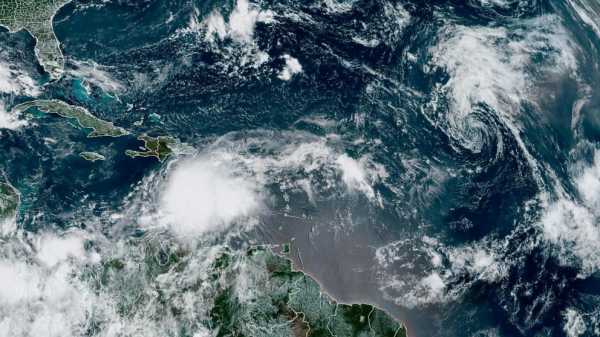
SAN JUAN, Puerto Rico — Tropical Storm Franklin churned through the Caribbean Sea on Monday as authorities in Haiti and the Dominican Republic warned residents to prepare for landslides and heavy floods.
The storm was centered at midafternoon about 275 miles (445 kilometers) south of Santo Domingo, the capital of the Dominican Republic. It had maximum sustained winds of 50 mph (85 kph). It was moving west at 4 mph (6 kph) but was forecast to make a sharp turn north late Monday or early Tuesday.
Franklin was expected to strengthen before making landfall late Tuesday in Hispaniola, the island shared by Haiti and the Dominican Republic.
The storm is forecast to drop up to 10 inches (25 centimeters) of rain in both countries, with up to 15 inches (38 centimeters) in isolated areas. Heavy rainfall is of great concern to Haiti, where severe erosion in many places often leads to dangerous flooding. More than 40 people died in June following a day of heavy rain from a thunderstorm.
“The mudslide risk there is just awful,” said Phil Klotzbach, a meteorologist at Colorado State University, noting that a slow-moving storm poses great danger in Haiti given that it's so stripped of trees.
Several Haitians in the capital of Port-au-Prince told The Associated Press that they didn't know a tropical storm was coming, despite authorities posting warnings on social media.
Marie Christine Bonjour, 39, who sells used clothes, said she didn't have any preparations in place.
“God is the only plan. He'll look over me and my kids,” she said. “There is nothing I can do.”
The storm approached as more than 200,000 people in Haiti are displaced, having to stay with family or in makeshift shelters because warring gangs pillaged and set fire to their homes.
“I hope God will direct the storm in another direction,” said street vendor Anne Jean-Pierre, 45. “We can't take any more.”
Jean-Pierre, who has moved twice already because of gang violence, said she would put her essential documents in a plastic bag because she lives in an area that floods easily.
A tropical storm warning was in effect for the entire southern coast of the Dominican Republic and Haiti. A tropical storm watch was iposted for the Turks and Caicos Islands.
Earlier Monday, there were three tropical storms swirling through the Caribbean and Atlantic Ocean, an unusual occurrence as the region braces for a busier than average hurricane season.
“We went from nothing to a lot in a day,” Klotzbach said.
One of those storms, Emily, dissipated late Monday morning, and another storm, Gert, was expected to do the same soon.
Franklin formed Sunday and was dropping heavy rain over parts of Puerto Rico on Monday, Gert formed overnight to become the eighth named storm of the Atlantic hurricane season. It formed some three weeks early compared with the dates of the eighth named storms from 1991 to 2020, said Brian McNoldy, senior research associated at University of Miami.
There have been 14 years with three named storms simultaneously in the Atlantic since 1886, Klotzbach said. The most storms the Atlantic has ever had at one time is four, a phenomena that has occurred only twice, in 1893 and 1995.
The Atlantic is smaller than the Pacific and can only accommodate so many storms, Klotzbach said, adding that Franklin was shearing apart Gert.
“One will basically kill the other one,” he said of storms that are too close to each other.
Meanwhile, a fourth system in the Gulf of Mexico was expected to soon become a tropical storm, as was a system off the coast of western Africa.
“We expected an active season,” said Odalis Martínez, a meteorologist with the National Weather Service in Puerto Rico. “It’s not surprising that we have several active storms.”
On Aug. 10, the National Ocean and Atmospheric Administration updated its forecast and warned that this year’s hurricane season would be above normal.
Between 14 to 21 named storms are forecast. Of those, six to 11 could become hurricanes, with two to five of them possibly becoming major hurricanes, the NOAA said.
The Atlantic hurricane season runs from June 1 to Nov. 30.
___
Associated Press writer Evens Sanon in Port-au-Prince, Haiti, contributed to this report.
Sourse: abcnews.go.com






